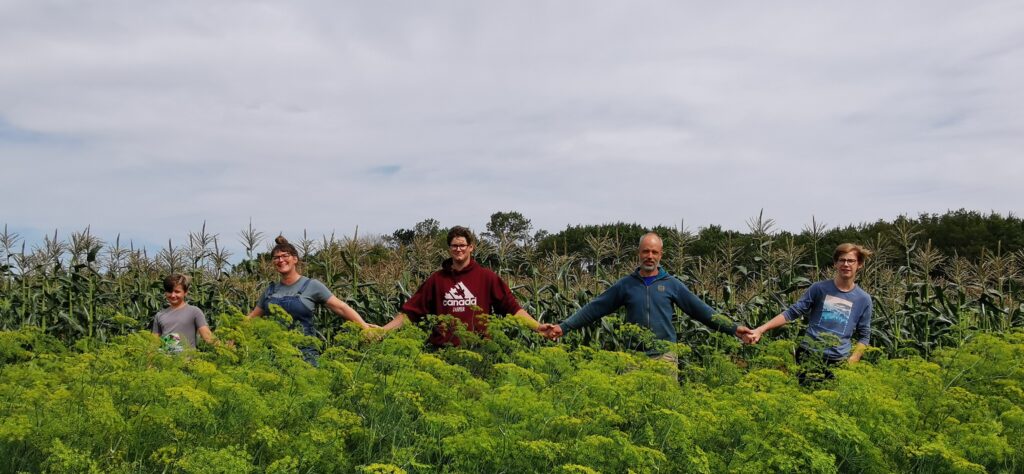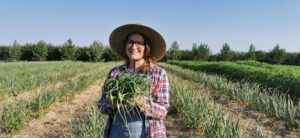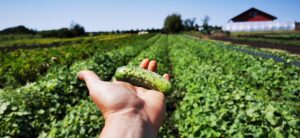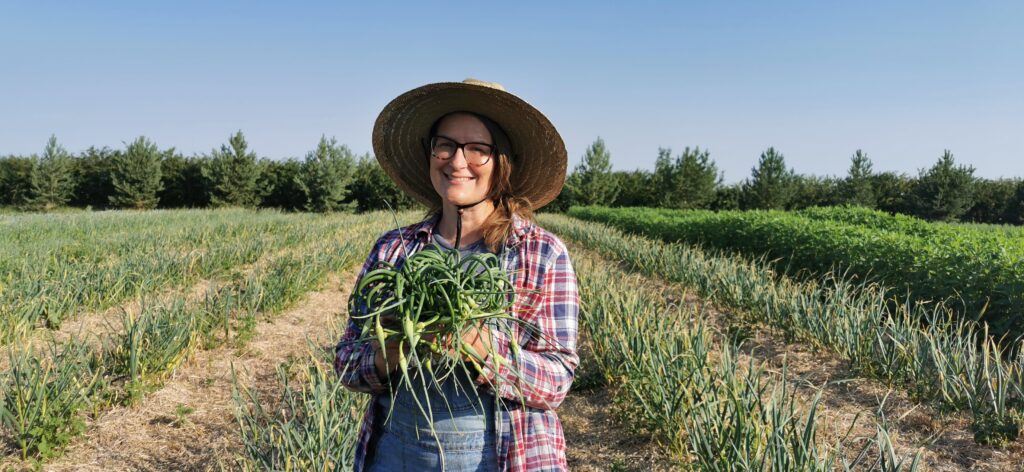By Trina Moyles
Jenny Berkenbosch and James Vriend manage Sundog Organic Farm, a 14-acre certified organic vegetable and herb operation, located north of Edmonton in Sturgeon County. They grow a wide range of field and greenhouse vegetables and herbs, and sell their organic produce to customers through a summer and fall Farm Share program, and as well, at Edmonton’s Strathcona Farmer’s Market.
Both Jenny and James have “farming in their blood”, as their grandparents ran market gardens in North Holland, although Jenny says she wasn’t aware her mom’s Opa (Jenny’s great-grandfather) was a market gardener until after she’d become a farmer. She’s two generations disconnected from farming, whereas, James grew up on an organic farm, managed by his parents, Dennis and Ruth Vriend, outside of Edmonton. They started Vriend Organic Farm in the 1980s in an effort to get back to their rural roots and rely on organic agriculture methods in the face of industrial food. After James and Jenny were married, she too spent 5 years working on the Vriend’s farm, learning about organic production.
In 2008, they were living in Edmonton with Jenny working as a teacher and professional visual artist, and James working as a cabinet maker. They had two young children and began to dream of getting back out onto the land to raise their family. Around that time, the local food movement was really taking off in Edmonton, as Jenny recalls. James’s parents were retired from their business, so their land was available to farm. It was “a perfect little incubator farm” with land, equipment, and storage space.
“It was a really casual, fun, 2-acre project,” recalls Jenny. ‘We started off managing a small CSA for friends, although we had way more food than we could use.”
In 2009, Sundog Organic Farm was born and they set up a booth at the Downtown farmer’s market in Edmonton. Jenny credits their backgrounds in the arts and cabinetry, for they designed and built a booth with “curb side appeal” and quickly developed a customer base that’s been loyal over the years. “It came together really beautifully,” says Jenny. After two years of farming on James’s family’s land, with the help of community connections, they managed to find land in Sturgeon County.
It was a “potato field”, as Jenny remembers, without any services or buildings. Over the past decade, Jenny and James, with the help of family and friends, have built Sundog Organic Farm, quite literally, from the ground up.
“We started out in a mobile home in the middle of a sea of mud,” says Jenny. “You would never know it to come here today, but we put in the driveway, installed water and power, planted trees, and put up every building here today.”
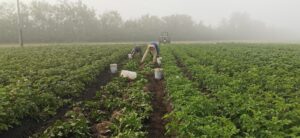
‘There’s No One Size Fits All’ — Adapting Regenerative Practices to Land/Climate
As Jenny and James moved their operation from family land to the potato field in Sturgeon County, they applied the same organic management and practices they’d previously relied on, including cover cropping with green manures. But they began to realize, some of what had worked on their former plots wasn’t necessarily going to work in their new location.
“What we’ve learned is that our land is actually quite different [from before], so we can’t just like grow green manures, till them in, and expect the same results,” explains Jenny.
Major rain events in 2019 and 2020 caused flooding and poor drainage for farmers in Alberta. At Sundog, the extreme rainfall resulted in standing water in the fields, which crippled many crops. “Our land was not absorbing the water at all,” says Jenny. “There was stagnant water standing, which leads to anaerobic processes in the soil — and that can be really detrimental for the long term.” The flooding prompted the couple to start researching for solutions, looking beyond the standard practices of organic management.
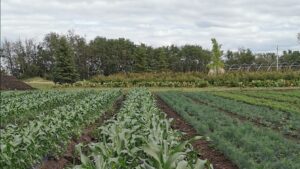
Their first line of thought was to install a tile drainage system on their land, which is a piping system that collects and redirects subsurface water that moves down into and through the soil. In recent years, tile drainage has become a common strategy used by Albertan farmers. But it can come at a cost. It’s expensive to install, costing up to $1.20 per foot, and can also impact riparian zones. Jenny and James realized they were too small-scale for it to be economically viable.
Instead, they began learning about regenerative agriculture practices and the importance of soil health. They hoped to address infiltration at the root of the issue: soil health. They sent off soil samples and began to focus on ways to nurture and improve the quality of their soil.
“We’ve got a soil that sticks together, it’s got high magnesium in it,” explains James. “As a result, we’ve been getting excess moisture — the soil doesn’t drain very well.”
They were also struggling with extreme weed pressure on the land, says James. He points out that organic production typically relies on tillage to manage weeds, since farmers aren’t using chemicals. “But what we’ve learned is that weeds are actually encouraged through the use of tillage. With any land disturbance, annual weeds or colonizers thrive.”
Through extensive research — reading articles, watching YouTube videos, listening to podcasts, including The No-Till Market Garden Podcast and Regenerative Agriculture Podcast by John Kempf — James and Jenny became fascinated with No-Till Agriculture and wondered if it could be a solution on their land. Jenny credits learning from Charles Dowding, JM Fortier, and particularly, Richard Perkins, who practices no-till at a similar northern latitude in Sweden.
No-till farming decreases the amount of soil erosion that tillage causes in certain soils, especially in sandy and dry soils on sloping terrain. Other possible benefits include an increase in the amount of water that infiltrates into the soil, soil retention of organic matter, and nutrient cycling.
“We’re hoping no-till can be a solution for the poor water drainage and weed pressure, but also for drought,” says James.
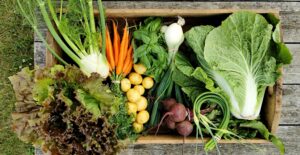
Building Blocks to No-Till — Deep Mulching, Biochar, and Modifying Equipment
Given the uncertainty of weather, transition to no-till hasn’t happened overnight at Sundog, rather Jenny and James decided to implement an interim solution in the 2021 season, which would give them time to map out the fields, prepare the soil, and modify equipment. As part of their interim solution, they invested in equipment for raised beds to help with drainage and used plasticulture—a thin film of plastic to cover the soil—to help with weed suppression.
“There are a lot of details that we needed time to plan for,” explains Jenny. “We had to figure out how big our beds would be, how we’d plant into them, and what kind of rotation we’d use that makes sense with no-till.”
Over the past summer, they’ve been focusing their efforts on preparing the future beds for no-till and improving the soil by adding organic amendments, including minerals—mostly calcium. In future seasons, Jenny says they aspire to add biochar and worm castings.
Biochar is a charcoal-like material that is produced from decomposing plant materials, such as grass, agricultural and forest residues, at high temperatures. During the process, the physical and chemical properties of the plant material change into a highly porous, stable, carbon-rich material known as biochar. The addition of biochar can help improve soil structure and quality by increasing the cation exchange capacity (CEC), surface area, and pH, along with the plant nutrient availability, while enhancing the water-holding capacity. They’re also experimenting with the deep mulching method, a technique borrowed from Richard Perkins who grows in a similar climate in Sweden. With deep mulching, they lay down a 4-inch thick, deep layer of compost over the surface of the oil.
“We’re aiming to mimic the forest floor by creating a protective layer over the soil that’s decomposing down,” explains Jenny. “The mulch is a barrier to prevent weeds from coming up.”
Deep mulching helps to protect the soil from erosion and regulate the temperature of the soil, as well, helping soil become more absorbent.
In order to lay down the deep mulch, they’ve had to modify some of their farm equipment to fully transition to no-till. A typical manure spreader, what folks call a “honey wagon”, typically sprays manure on the field. But James changed the gear settings on one of the wagons so that it dumps manure, as opposed to spraying it everywhere. Jenny points out that transitioning to a new method can take time and modifying equipment is a critical part of that, particularly on the larger scale operation at Sundog.
The Way of the Future? Organic No-Till Movement
Farming comes with enormous financial challenges and uncertainty, but James and Jenny appreciate the rewards of the job: living closely with nature, raising their family in a healthy environment, and growing good food for local communities. Through their Farm Share CSA, they feed 270 families, and reach hundreds more at weekly farmer’s markets.
While organic no-till farming isn’t yet a widespread practice amongst farmers in North America, it’s becoming more commonly adopted in Europe. Jenny recommends the resources, The No-Till Organic Vegetable Farm by Daniel Mays, along with No-Till Intensive Vegetable Culture by Bryan O’Hara. But she also points out that experimentation is key to adapting to local environments.
“I think one of the overarching things that we’ve learned is that there isn’t a ‘one size fits all’ solution,” says Jenny. “With no-till agriculture, I think there are a lot of creative responses that happen on the ground that are dependent on local soil, environment, and growing circumstances.”
James and Jenny are hopeful that the introduction of no-till practices will help to improve soil health and adapt to the unique growing conditions on their land, but they acknowledge that it takes time.
“You don’t get results instantly, or within a week, it’s a long game, you know?” Jenny says. “I think keeping that in mind is interesting and valuable. It’s like a slow approach to life.”
Jenny and James’ farming practices have always began with respect for the soil. Their farm, located in Sturgeon County, grows a wide range of organic field and greenhouse produce.
Both Jenny and James have a heritage of market gardening that extends to their families in the Netherlands. Farming is literally in their blood! In the early 1980’s James’ parents decided to return to the land after some 20 years away from their rural roots. The farming traditions instilled into Sundog Organic Farm could be traced through them all the way back to North Holland where there still exist Vriend families thriving in horticulture.
Learn more about Sundog Organic Farm!

